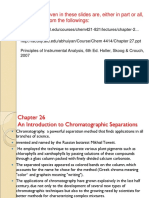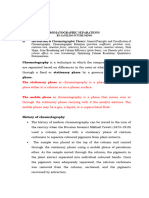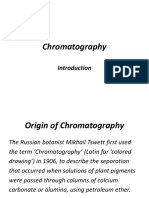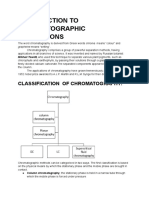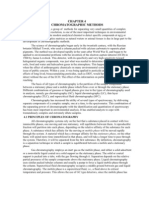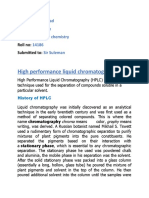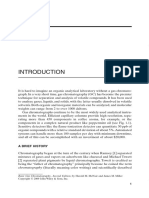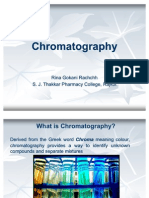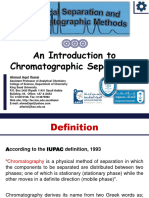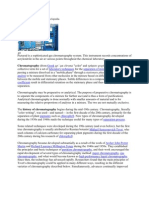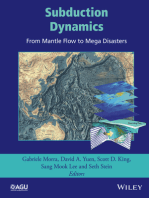0 ratings0% found this document useful (0 votes)
248 viewsAn Chem CH 26
An Chem CH 26
Uploaded by
Naga SaktiChromatography was invented in the early 20th century by Russian botanist Mikhail Tswett. He passed plant pigment solutions through columns packed with calcium carbonate, separating the species into colored bands based on their migration rates. Chromatography techniques separate mixtures based on differences in how fast components move through a stationary phase carried by a liquid or gas mobile phase. Column and planar chromatography both rely on equilibria between phases. Chromatography is a powerful and widely used analytical method for separating, identifying, and quantifying the chemical components in complex mixtures.
Copyright:
© All Rights Reserved
Available Formats
Download as PDF, TXT or read online from Scribd
An Chem CH 26
An Chem CH 26
Uploaded by
Naga Sakti0 ratings0% found this document useful (0 votes)
248 views19 pagesChromatography was invented in the early 20th century by Russian botanist Mikhail Tswett. He passed plant pigment solutions through columns packed with calcium carbonate, separating the species into colored bands based on their migration rates. Chromatography techniques separate mixtures based on differences in how fast components move through a stationary phase carried by a liquid or gas mobile phase. Column and planar chromatography both rely on equilibria between phases. Chromatography is a powerful and widely used analytical method for separating, identifying, and quantifying the chemical components in complex mixtures.
Original Title
AnChemCh26
Copyright
© © All Rights Reserved
Available Formats
PDF, TXT or read online from Scribd
Share this document
Did you find this document useful?
Is this content inappropriate?
Chromatography was invented in the early 20th century by Russian botanist Mikhail Tswett. He passed plant pigment solutions through columns packed with calcium carbonate, separating the species into colored bands based on their migration rates. Chromatography techniques separate mixtures based on differences in how fast components move through a stationary phase carried by a liquid or gas mobile phase. Column and planar chromatography both rely on equilibria between phases. Chromatography is a powerful and widely used analytical method for separating, identifying, and quantifying the chemical components in complex mixtures.
Copyright:
© All Rights Reserved
Available Formats
Download as PDF, TXT or read online from Scribd
Download as pdf or txt
0 ratings0% found this document useful (0 votes)
248 views19 pagesAn Chem CH 26
An Chem CH 26
Uploaded by
Naga SaktiChromatography was invented in the early 20th century by Russian botanist Mikhail Tswett. He passed plant pigment solutions through columns packed with calcium carbonate, separating the species into colored bands based on their migration rates. Chromatography techniques separate mixtures based on differences in how fast components move through a stationary phase carried by a liquid or gas mobile phase. Column and planar chromatography both rely on equilibria between phases. Chromatography is a powerful and widely used analytical method for separating, identifying, and quantifying the chemical components in complex mixtures.
Copyright:
© All Rights Reserved
Available Formats
Download as PDF, TXT or read online from Scribd
Download as pdf or txt
You are on page 1of 19
Chromatography was invented by the
Russian botanist Mikhail Tswett shortly
after the tum of this century. He passed
solutions containing plant pigments,
such as chlorophyUs and xantbopbylls,
through glass columns packed with
fi nely diviaed oalcium carbonate. The
separated species appeared as colored
bands on the column, which accounts
for the name he chQse for the method
(Greek: chroma meani:ng "color" and
graphein meaning "to write ").
Chromatography is a technique in
which the components of a mhture are
separated based on the rates at which
they are carried through a stationary
phase by a gaseous or liquid mobile
phase.
Planar and column chromatography are
based on the same types of equilibria.
490
CHAPTER 26
--
AN INTRODUCTION TO
CHROMATOGRAPHIC
METHODS
Chromatography is an analytical method that is widely used for the separation,
identification, and determination of the chemical components in complex mix-
tures. No other separation method is as powelful and generally applicable as is
chromatography.
1
.
26A A GENERAL DESCRIPTION OF CHROMATOGRAPHY
The term chromatography is difficult to define rigorously because the name has
been applied to such a variety of systems and teclmiques. All of these methods,
however, have in common the use of a stationary phase and a mobile phase.
Components of a mixture are carried through the stationary phase by the flow
of a gaseous or liquid mobile phase, separations being based on differences in
migration rates among the sample components.
26A-l Classification of Chromatographic Methods
Chromatographic methods are of two lypes. In column chromatography, the
stationary phase is held in a narrow tube and the mobile pha5e is forced through
the tube under pressure or by gravity. In planar chromatography, the stationary
I General references on chromatography include: Chromatography: FU/ldamentals and Applications
of Chromatography a/ul Eleclropliolometric Methods, Part A Fundamentals, PorI B Applications,
E. Heftmann. Ed. New York: Elsevier, 1983; P. Sewell and B. Clarke, Chromatographic Separations.
New Yo(k: Wiley, 1988; Chromatographic Theory and Basic Principles, J. A. Jonsson, Ed. New
York: Marcel Dekker, 1987; J. C. Giddings. Unified Separation Sciellce. New York: Wiley, 1991.
----
tion,
rrux-
as is
: has
lads,
lase.
flow
~ s in
the
)ugh
nary
rlions
rions,
riolls.
New
99l.
26A A General Description of Chromatography 491
-r:-
phase is supported on a flat plate or in the pores of a paper. Here the mobile phase
moves through the stationary phase by capillary action or under the influence of
gravity. We will deal with column chromatography only.
As shown in the first column of Table 26-1, chromatographic methods fall
into three categories based on the nature of the mobile phase. The three types
of phases include liquids, gases, and supercritical fluids. The second column of
the table reveals that there are five types of liquid chromatography and three
types of gas chromatography that differ in the nature of the stationary phase and
the types of equilibria between phases.
26A-2 Elution Chromatography
Figure 26-1 shows how two components , A and B, are resolved on a column by
elution chromatography. Elution involves washing a solute through a column by
additions of fresh solvent. A single pOl1ion of the sample dissolved in the mobile
phase is introduced at the head of the colurrm (at time to in Figure 26-1), where
components A and B distribute themselves between the two phases. Introduction
of additional mobile phase (the eluent) forces the dissolved portion of the sample
down the coluIID1, where further partition between the mobile p h ~ ~ e and fresh
portions of the stationary phase occurs (time II)' Partitioning between the fresh
solvent and the stationary phase takes place simultaneously at the original site
of the sample.
Further additions of solvent cany solute molecules down the column in a
continuous series of transfers between the two phases. Because solute movement
can occur only in the mobile phase, the average rate at '!Vhich a solute migrates
depends on the fraction of time it spends in that phase. This fraction is small
Table 26-1
CLASSIFICATION OF COLUMN CHROMATOGRAPHIC METHODS
General Classification Specific Method Stationary Phase
Liquid chromatography can be performed
in columns and 011 planar surfaces, but gas
chromatography is restricted to col umn pro-
cedures.
Elution is a process in which solutes
are washed through a stationary phase
by the movement of a mobile phase.
An eluent is a solvent used to can'Y the
components of a mixture through a sta-
tionary phase.
Type of Equilibrium
Liquid chromatography
(LC) (mobile phase:
liquid)
Liquid-liquid, or partiti on Liquid adsorbed on a solid Partition between immisci-
ble liquids
Gas chromatography (GC)
(mobile phase: gas)
Supercritical-fluid chroma-
tography (SFC) (mobile
phase: supercritical fluid)
Liquid-bonded phase
Liquid-solid, or adsorption
Ion exchange
Size exclusion
Gas-liquid
Gas-bonded phase
Gas-solid
Organic species bonded to a
solid surface
Solid
Ion-exchange resin
Liquid in interstices of a
polymeric solid
Liqui d adsorbed on a solid
Organic species bonded [0 a
solid surface
SoUd
Organic species bonded to a
solid surface
Partition between liquid
and bonded surface
Adsorpt.ion
Ion exchange
Partition/sieving
Partition between gas and
liquid
Partition between liquid
and bonded surface
Adsorption
Partition between supercriti-
cal fluid and bonded sur-
face
492 Chapter 26 An Introduction to Chromatographic Methods
Figure 26-1
(a) Diagram showing the separation of
a mixture of components A and B by
column elution chromatography. (b)
The output of the signal detector at
the various stages of elution shown
in (a).
A chromatogram is a plot of some func-
tion of solute concentration versus elu-
tion time or elution velume. -
Sample
A+B
Packed
column
..... ~
~ ~
to
B
A
Mobile phase
(a)
A
8 I
O ~ L-L __________ _________ ________ __________
to
Time
(b)
Detector
for solutes that are strongly retained by the stationary phase (component B in
Figure 26-1, for example) and large where retention in the mobile phase is
more likely (component A). Ideally, the resulting differences in rates cause the
components in a mixture to separate into bands, or' zones, along the length of
the column (see Figure 26-2). Isolation of the separated species is then accom-
plished by passing a sufficient quantity of mobile phase through the column to
cause the individual bands to pass out the end (to be eluted from the column),
where they can be collected (times t3 and t4 ill Figure 26-1).
Chromatograms
If a detector that responds to solute concentration is placed at the end of the
column and its signal is plotted as a function of time (or of volume of added
mobile phase), a series of symmetric peaks is obtained, as shown in the lower
part of Figure 2 6 ~ 1 Such a plot, called .a chromatogram, is useful for both
.ector
Bin
se is
~ the
th of
~ o m
m to
ron),
,f the
.dded
ower
both
26B Migration Rates of Solutes 493
t
Distance migrated
qualitative and quantitative analysis. The positions of the peaks on the time axis
can be used to identify the components of the sample; the areas under the peaks
provide a quantitative measure of the amount of each species.
The Effects of Relative Migration Rates
and Band Broadening on Resolution
Figure 26-2 shows concentration profiles for the bands containing solutes A and
B on the column in Figure 26-1 at time It and at a later time t3.
2
Because B is
more strongly retained by the stationary phase than is A, B lags during the
migration. Clearly, the distance between the two increases as they move down
the column. At the same time, however, broadening of both bands takes place,
whjch lowers the efficiency of the column as a separating device. While band
broadening is inevitable, conditions can often be found where it occurs more
slowly than band separation. Thus, as shown in Figure 26-2, a clean separation
of species is possible provided the column is sufficiently long.
Several chemical and physical variables influence the rates of band separation
and band broadening. As a consequence, improved separations can often be
realized by the control of variables that either (1) increase the rate of band
separation, or (2) decrease the rate of band spreading. These altematives are
illustrated in Figure 26-3.
The variables that influence the relative rates at which solutes migrate through
a stationary phase are described in the next section. Following this discussion,
we tum to those factors that playa part in zone broadening.
26B MIGRATION RATES OF SOLUTES
The effectiveness of a chromatographic column in separating two solutes depends
in part on the relative rates at which the two species are eluted. These rates are
in tum determined by the partition ratios of the solutes between the two phases.
26B-1 Partition Ratios in Chromatography
All chromatographic separations are based on differences in the extent to which
solutes are partitioned between the mobile and the stationary phase. For the solute
2 Note that the relative positions of the bands for A and B in the concentration profile in Figure
26-2 appear to be reversed from Iheir positions in the lower part of Figure 26- [. The difference is
that the abscissa is distance along the colunm in Figure 26-2 but time in Figure 26-1. Thus, in Figure
26-1. the /1'0111 of a peak lies to 1he left and Ihe tail (0 the right; in Figure 26-2. the reverse is true.
Figure 26-2
Concentration profiles of solute bands
A and B at two different times in their
migration down the column in Figure
26-1. The times I, and t3 are indicated
in Figure 26-1.
1
, ___ -"M---(C)
Time
Figure 6 ~ 3
Two-component chromatograms illus-
trating two methods of improving sepa-
ration: (a) original chromatogram with
overlapping peaks; improvement
brought about by (b) an increase in
band separation; and (c) a decrease in
bandwidth.
494 Chapter 26 An Introduction to Chromatographic Methods
The retention time tR is the ti me
between injection of a sample and the
appearance of a solute peak at the detec-
tor of a chromatograpbic column.
The dead time tM is the time it takes for
an un retained species to pass through a
column.
Figure 26-4
A typical chromatogram for a two-
component mixture. The small peak
on the left represents a solute that is
not retained on the column and so
reaches the detector almost immedi-
ately after elution is started. Thus its
retention time 1M is approximately
equal to the time requjred for a mole-
cule of the mobile phase to pass
through the column.
species A, the equilibrium involved is described by the equation
The equilibrium constant K for this reaction is called a partition ratio, or partition
coefficient, and is defined as
(26-1 )
where Cs is the molar analytical concentration of a solute in the stationary phase
and CM is its analytical concentration in the mobile phase. Ideally, the prutition
ratio is constant over a wide range of solute concentrations; that is, Cs is directly
proportional to CM'
268-2 Retention Time
Figure 26-4 is a simple chromatogram made up of just two peaks. The small
peak on the left is for a species that is not retained by the stationary phase. The
time tM after sample injection for this peak to appear is sometimes called the
dead time. The dead time provides a measure of the average rate of migration
of the mobile phase and is an important parameter in identifying analyte peaks.
Often the sample or the mobile phase will contain an unretained species. When
they do not, such a species may be added to aid in peak identification. The larger
peak on the right in Figure 26-4 is that of an analyte species. The time required
for this peak to reach the detector after sample injection is called the retention
time and is given the symbol tn.
The average Unear rate of solute migration, V, is
(26-2)
where L is the length of the column packing. Similarly, the average linear velocity,
U, of the molecules of the mobile phase is
2 6 ~ 3 )
Time
?n
1)
lse
on
tly
tali
'he
the
ion
ks.
len
ger
red
ion
.-2)
:ity,
)-3)
268 Migration Rates of Solutes 495
268-3 The Relationship Between Migration
Rate and Partition Ratio
In order to relate the rate of migration of a solute to its partition ratio, we express
the rate as a fraction of the velocity of the mobile phase:
v = u X fraction of time solute spends in mobile phase
This fraction, however, equals the average number of moles of solute in the
mobile phase at any instant divided by the total number of moles of solute in
the column:
_ moles of solute in mobile phase
v = Ll X ------------"---
total moles of solute
The total number of moles of solute in the mobile phase is equal to the molar
concentration, CM, of the solute in that phase multiplied by its volume, V
M
Similarly, the number of moles of solute in the stationary phase is given by the
product of the concentration, cs, of the solute in the stationary phase and its
volume, Vs . Therefore, ~
Substitution of Equation 26-1 into this equation gives an expression for the
rate of solute migration as a function of its partition ratio as well as a function
of the volumes of the stationary and mobile phases:
_ I
v=uX-----
I + KVslVM
(26-4)
The two volumes can be estimated from the method by which the column is
prepared.
26B-4 The Capacity Factor
The capacity factor is an important experimental parameter that is widely used
to describe the migration rates of solutes on columns. For a soLute A, the capacity
factor k ~ is defined as
(26-5)
where KA is the partition ratio for the species A. Substitution of Equation 26-5
into 26-4 yields
_ 1
v=uX--
1 + ~
(26-6)
Michael Tswelt (1872-1919), a Rus-
sian botanist, discovered the basic prin-
ciples of column chromatography. He
separated plant pigments by eluting a
mixture of the pigments on a column
of calcium carbonate. The various pig-
ments separated into colored bands;
hence the name chromatography.
496 Chapter 26 An Introduction to Chromatographic Methods
Ideally, the capacity factor for analytes in a
sample is between 1 and 5.
The selectivity factor for !wo analytes in a
column provides a measure of how well
the column will separate the !Wo.
In order to show how ~ can be derived from a chromatogram, we substitute
Equations 26-2 and 26-3 into Equation 26-6:
L L 1
-=-x--
tR IN! 1 + ~
(26-7)
This equation reananges to
(26-8)
As shown in Figure 26-4, til and tM are readily obtained from a chromatogram.
When the capacity factor for a solute is much less than unity, elutl0n occurs so
rapidly that accurate determination of the retention times is difficult. When the
capacity factor is larger than perhaps)O to 30, elution times become inordinately
long. Ideally, separations are peIformed under conditions in which the capacity
factors for the solutes in a mixture are in the range between] and 5.
The capacity factors in gas chromatography can be varied by changing the
temperature and the column packing. In liquid chromatography, capacity factors
can often be manipulated to give better separations by varying the composition
of the mobile phase and the stationary phase.
268-5 Relative Migration Rates: The Selectivity Factor
The selectivity factor a of a column for the two species A and B is defined as
(26-9)
where KB is the partition ratio for the more strongly retained species Band KA
is the constant for the less strongly held or more rapidly eluted species A.
According to this definition, a is always greater than unity.
Substitution of Equation 26-5 and the analogous equation for solute B into
Equation 26-9 provides after reanangement a relationship between the selectivity
factor for two solutes and their capacity factors:
ks
a= - (26-10)
~
where ~ and ~ are the capacity factors for B and A, respe.ctively. Substitution
of Equation 26-8 for the two solutes into Equation 26-10 gives an expression
:e
-8)
TI.
so
he
:ly
.ty
he
)rs
on
as
-9)
nto
lity
10)
tion
;ion
26C The Efficiency of Chromatographic Columns 497
that penn its the determination of a from an chromatogram:
(26-11 )
In Section 26D- l we show how we use the selectivity factor to compute the
resolving power of a column.
26C THE EFFICIENCY OF CHROMATOGRAPHIC COLUMNS
The efficiency of a chromatographic column refers to the amount of band broaden-
ing that occurs when a compound passes through the column. Before defining
column efficiency in more quantitative tenns, let us examine the reasons that
bands become broader as they move down a column.
26C-l The Rate Theory of Chromatography
The rate theory of chromatography describes the shapes and breadths of elution
peaks in quantitative terms based on a random-walk mechanism for the migration
of molecules through a column. A detailed discussion of the rate theory is beyond
the scope of this book.
3
We can, however, give a qualitative picture of why bands
broaden and what variables improve column efficiency.
If you examine the chromatograms shown in this and the next chapter, you
will see that the elution peaks look very much like the Gaussian or normal error
curves that you encountered in Chapters 4 and 5. As shown in Section 4B, normal
error curves are rationalized by assuming that the uncertainty associated with
any single measurement is the summation of a much larger number of small,
individually undetectable and random unceltainties, each of which has an equal
probability of being positive or negative. In a similar way, the typical Gaussian
shape of a chromatographic band can be attributed to the additive combination
of the random motions of the myriad molecules making up a band as it moves
down the column.
It is instructive to consider a single solute molecule as it undergoes many
thousands of transfers between the stationary and the mobile phases during
elution. Residence time in either phase is highly irregular. Transfer from one
phase to the other requires energy, and the molecule must acquire this energy
from its surroundings. Thus, the resjdence time in a given phase may be transitory
for some molecules and relatively long for others. Recall that movement down
the column can occur only while the molecule is in the mobile phase. As a
consequence, certain particles travel rapidly by virtue of their accidental inclusion
in the mobile phase for a majority of the time, whereas others lag because they
happen to be incorporated in the stationary phase for a greater-than-average
length of time. The result of these random individual processes is a symmetric
spread of velocities around the mean value, which represents the behavior of the
average analyte molecule.
J See J. J. Hawkes, 1. Chern. Educ . 1983. 60, 393.
Some chromatographic peaks are non ideal
and exhi bit tailillg or frollting. In the for-
mer case the tail of the peak, appearing to
the right on the chromatogram, is drawn
out while the front is steepened. Wi th front-
ing, the reverse is the A common
cause of tailing and fronti ng is a nonlinear
distribution coefficient. Fronting also
occurs when Ule sample introduced onto a
column is too large. Distort ions of this
kind are undesirable because they lead to
poorer separations and less reproducible
elution times. In our discussion we assume
Ulat tailing and fronting are mi ni mal.
498 Chapter 26 An Introduction to Chromatographic Methods
The plate height H is also known as the
height equivalent of a theoretical plate
(HETP).
The efficiency of a column is great when
H is small and N is large.
Figure 26 5
Flow
direction
!
Typical pathways of two molecules
during elution. Note that the distance
traveled by molecule 2 is greater than
that traveled by molecule 1. TIlUs,-mol
ecule 2 will arrive at B later than mole-
cule 1.
Diffusion also contTibutes to band broadening. Recall from Section [9A-2 that
molecules tend to diffuse from a more concentrated part of a solution to a more
dilute, the rate being proportional to the concentration difference. In the center
of a chromatographic band, the concentration of a species is high, while at the two
edges the concentration approaches zero. Therefore, molecules tend to migrate to
either edge of the band. Band broadening is the result. Note that half of the
diffusion will be in the direction of flow and the other half in an opposed direction.
Another cause of band broadening is shown in Figure 26-5, which shows that
indi vidual molecules in the mobile phase follow paths of different lengths as
they traverse the column. Thus, their arrival time at the detector differs, and
bands are broader as a consequence.
The breadth of a band increases as it moves down the column because more
time is allowed for spreading by these valious mechanisms to occur. Thus, zone
breadth is directly related to residence time in the column and inversely related
to the flow velocity of the mobile phase.
26C-2 A Quantitative Description of Column Efficiency
Two related tenus are widely used as quantitative measures of the efficiency of
chromatographic columns: (1) plate lieight Hand (2) number of theoretical pLates
N. The two are related by the equation
N = LIH (26-12)
where L is the length (usually in centimeters) of the column packing. Feature
26-1 describes how these measures of column efficiency got their names.
The efficiency of chromatographic columns increases as the number of plates
becomes greater and as the plate height becomes smaller. Enonnous differences
Feature 26-1
WHAT IS THE SOURCE OF THE TERMS PLATE AND PLATE HEIGHT?
The 1952 Nobel Prize for chemistry was awarded to two Englishmen, A. J.
P. Martin and R. L. M. Synge, for their work in the development of modern
chromatography. In their theoretical studies, they adapted a model that was
first developed in the early 1920s to descIibe separations on fractional distilla-
tion columns. Fractionating columns, which were first used in the petroleum
industry for separating closely related hydrocarbons, consisted of numerous
intercOlmected bubble-cap plates (see Figure 26-A) at whlch vapor-Liquid
equilibria were established when the column was operated under reflux
conditions.
Martin and Synge treated a chromatographic column as if it were made
up of a series of contiguous bubble-cap-like plates, within which equilibrium
conditions always prevail. This plate model successfully accounts for the
Gaussian shape of ebromatographle peaks as well as for factors that influence
differences in solute-migration rates. The plate model is totally incapable of
accounting for zone broadening, however, because of its basic assumption
tat
Ire
:er
'10
to
he
In.
Lat
as
nd
,re
ne
ed
of
2)
.re
:es
es
26C The Efficiency of Chromatographic Columns 499
+1
Bubble cap plate
column
Figure 26-A
P1ates in a fractionating column.
that equilibrium conditions prevail throughout a column during elution. Th.is
assumption can never be valid in the dynamic state that exists in a cJu'omato-
graphic column, where phases are moving past one another at sLlch a pace
that sufficient time is not available for equilibration.
in efficiencjes are encountered in columns, depending on their type and the kinds
of mobile and stationary phases they con.tain. Efficiencies in (enns of plate
numbers can vary from a few hundred to several hundred thousand; plate heights
from a few tenths to one thousandth of a centimeter or smaller are not uncommon.
Definition of Plate Height, H
Tn Section 4C-2, we pointed out that the breadth of a Gaussian curve is described
by the standard deviation (J" and the variance cr. Because chromatographic bands
are also Gaussian and because the efficiency of a column is reflected in the
breadth of chromatographic peaks, the variance per unit length of column is used
by cIu'omatographers as a measure of column efficiency. That jo, the column
Stamp in honor of biochemists Archer
1. P. Martin (b. J 9 10) and Richard
L. M. Synge (b. 1914) who were
awarded the 1952 Nobel PLize in
chemistry for their contributions to
the development of modern chroma-
tography.
500 Chapter 26 An Introduction to Chromatographic Methods
Figure
Definition of plate height H = c?/L.
Fi gure 26-7
Determination of the standard devia-
tion T from a chromatographic peale
W = 47".
(b)
(a)
Sample
In
efficiency H is defined as
Analyte profile
at end of packing
L
Distance migrated-
.,
H=(T
L
Detector
(26-13)
This definition of column efficiency is illustrated in Figure 26-6a, which shows
a column that has a packing L cm in length. Above this schematic is a plot
showing the distribution of molecules along the length of the column at the
moment the analyte peak reaches the end of the packing (that is, at the retention
time tR)' The curve is Gaussian, and the locations of L + 1 (J" and L - to" ate
indicated as broken vertical lines. Note that L calTies units of centimeters and
a1 units of centimeters squared; thus H represents a linear distance in centimeters
as well (Equation 26-13). In fact, the plate height can be thought of as the length
of column that contains a fraction of the analyte that lies between Land L - 0".
Because the area under a nom1al error curve bounded by 0" is about 68% of
the total area (page 62), the plate height, as defined, contains 34% of the analyte.
Experimental Determination of the Number of Plates in a Column
The number of theoretical plates, N, and the plate height, H, are widely used in
the literature and by instrument manufacturers as measures of column pedor-
mance. Figure 26-7 shows how N can be determined from a chromatogram. Here,
the retention time of a peak tR and the width of the peak at its base W (in units
of time) are measured. It can be shown (see Feature 26-2) that the number of
\ I
o
Time-
J)
vs
ot
le
)0
re
ld
:th
CT.
of
teo
re,
lits
of
26C The Efficiency of Chromatographic Columns 501
plates can then be computed by the simple relationship
(
t )2
N= 16 ;
(26-14)
To obtain H, the length of the column L is measured and Equation 26-12
applied.
Feature 26-2
DERIVATION OF EQUATION 26-14
The variance of the peak shown in Figure 26-7 has units of seconds squared
because the abscissa is time in seconds (or sometimes in minutes) . Thi s
time-based variance is usually designated as r to distinguish it from fil,
which has units of centlineters squared. The two standard deviations 'T and
(J' are related by
(26-15)
where LJ tR is the average linear of the solute in centimeters per
second.
Figure 26-7 illustrates a simple means for approximating 'T from an experi-
mental chromatogram. Tangents at the inflection points on the two sides of
the chromatographic peak are extended to fmm a triangle with the base line.
The area of this triangle can be shown to be approximately 96% of the total
area under the peak. In Section 5B-2 it was shown that about 96% of the
area under a Gaussian peak is included within plus or minus two standard
deviations ( 2CT) of its maximum. Thus, the intercepts shown in Figure 26-7
occur at approximately 27 from the maximum, and W = 47, where W 1S
the magnitude of the base of the triangle. Substituting this relationship into
Equation 26-15 and rearranging yields
LW
u=-
4tR
Substitution of tills equation for a' into Equation 26-13 gives
(26-16)
To obtain N, we substitute into Equation 26-12 and rearrange to get
Thus, N can be calcuJated from two time measurements, tR and W; to obtain
H, the length of the column packing L must also be known.
502 Chapter 26 An Introduction to Chromatographic Methods
Figure 26-8
Effect of mobile-phase flow rate on
plate height for (a) liquid chromatogra-
phy and (b) gas chromatography.
26C-3 Variables that Affect Column Efficiency
Band broadening, and thus loss of coluITUl efficiency, is the consequence of the
finite rate at which several mass-transfer processes occur during migration of a
solute down a coluITUl. Some of the variables that affect these rates are controllable
and can be exploited to improve separations.
The Effect of Mobile-Phase Flow Rate
The extent of band broadening depends on the length of time the mobile phase
is in contact with the stationary phase. Therefore, as shown in Figure 26-8,
column efficiency depends on the rate of flow of the mobile phase. Note that for
both liquid and gas-liquid chromatography, minimum plate heights (or maximum
efficiencies) occur at relatively low flow rates. Maximum efficiency for liquid
chromatography occurs at rates that are well below those for gas chromatography.
[n fact, the minima for liquid chromatography are often so low that they are not
observed under ordinary operating conditions.
Generally, liquid chromatograms are obtained at lower ft.ow rates than gas
chromatograms. Furthermore, as shown in Figure 26-8, plate heights for liquid
chromatographic colunms are an order of magnitude or more smaller than those
of gas chromatographic columns. Offsetting this advantage, however, is the
difference in lengths of the two types of columns. Gas chromatographic columns
can be 50 m or more in length. Liquid columns, on the other hand, can be no
longer than 25 to 50 cm because of the high pressure drops along their lengths.
As a consequence, the number of plates, N, in a gas chromatographic column
may exceed that in a liquid chromatographic column by a factor of several
hundred.
0.4
(a) Liquid chromatography
0.3
8
S 0.2
0.1
o 0.5 1.0 1.5
Linear flow rate, cm/s
8.0
(b) Gas-liquid chromatography
7.0
El 6.0
El
5.0
4.0
3.0
0 2.0 4.0 6.0 8.0
Linear flow rate, cm/s
0.2
~
.0
00
0.6-0.8 mm
'0
..d
Q)
0.3-0.4 mm
~ 0.1
p...
5 10 15 20
Linear velocity, cm/s
Other Variables
It has been found that column efficiency can be increased by decreasing the
particle size of column packings, by employing thinner layers of the immobilized
film (where the stationary phase is a liquid adsorbed on a solid), and by lowering
the mobile-phase viscosity, Increases in temperature also reduce band broadening
under most circumstances. Figure 26-9 illustrates how particle size affects plate
heights of gas-liquid chromatographic columns.
26D COLUMN RESOLUTION
The resolution Rl of a column provides a quantitative measure of its ability to
separate two analytes. The significance of this term is illustrated in Figure 26-10,
which consists of chromatograms for species A and B on three columns with
different resolving powers. The resolution of each column is defined as
R = 2ilZ 2[(tR)a - (tR)A]
~ W
A
+ W
B
W
A
+ W
B
(26-17)
where all of the terms on the right side are as defined in the figure.
It is evident from the figure that a resolu tion of 1.5 gives an essentially complete
separation of A and B, whereas a resolution of 0.75 does not. At a resolution of
1.0, zone A contains about 4% B and zone B contains about 4% A. At a resolution
of 1.5\ the overlap is about 0.3%. The resolution for a given stationary phase
can be improved by lengthening the column, thus increasing the number of plates.
An adverse consequence of the added plates, however, is an increase in the time
required for the resolution.
26D-1 Effect of Capacity and Selectivity Factors on Resolution
A useful equation is readily derived that relates the resolution of a column to
the number of plates it contains, as well as to the capacity and selectivity factors
260 Column Resolution 503
Figure 26-9
Effect of particle size on plate height.
The numbers to the right are particle
diameters. (From J. Boheman and
J. H. Purnell, in Gas Chromatography
1958, D. H. Desty, Ed. New York:
Academic Press, 1958. With pennis-
sion of Butterworths, Stoneham, MA.)
504 Chapter 26 An Introduction to Chromatographic Methods
Figure 26-10
Separation at three resolutions: Rs =
2AZ/(WA + W
Il
) .
Rs = 0.75
a
1
....
0
0
t)
i
(tR)H
cO
I
Cl
1.5
o Time-
of a pair of solutes on the column. It can be shown
4
that for the two solutes A
and B in Figure 26-10, the resolution is given by the equation
R =
s 4 lX 1 +
(26-18)
where is the capacity factor of the slower-moving species and Ol. is the selectivity
factor. This equation can be rearranged to give the number of plates needed to
realize a given resolution:
N = 16R; _CX_ _ _B
( )
2(1 + kl)2
lX - 1 ks
(26-19)
260-2 Effect of Resolution on Retention Time
As mentioned earlier, the goal in chromatography is the highest possible resolution
in the shortest possible elapsed time. Unfortunately, these goals tend to be incom-
patible; consequently, a compromise between the two is usually necessary. The
4 See D. A. Skoog and J. J. Leary, Principles of Instrumenfal Analysis, 4th ed., pp. 592-593.
Philadelphia: Saunders College Publishing, 1992.
time (tR)B required to elute the two species in 26-10 with a resolution of
Rs is given by
t _ 16R;H (_0'._)2 (1 +
( R)B - U a - 1
(26-20)
where u is the linear velocity of the mobile phase.
Example 26-1
Substances A and B have retention times of 16.40 and 17.63 min, respectively,
on a 30.0-cm column. An unretained species passes through the column in 1.30
min. The peak widths (at base) for A and B are 1.11 and 1.21 min, respectively.
Calculate (a) column resolution, (b) average number of plates in the column, (c)
plate height, (d) length of column required to achieve a resolution of 1.5, and
(e) time required to elute substance B on the longer column.
(a) Employjng Equation 26-17, we find
R.l = 2(17.63 -16.40)/(1.11 + 1.21) = 1.06
(b) Equation 26-14 permits computation of N:
N = 16 (16.40)2 = 3493 and N = 16 (17.63)2 = 3397
1.11 1.21
= (3493 + 3397)/2 = 3445 = 3.4 X 10
3
(c)
H = LIN = 30.013445 = 8.7 X 10-
3
em
(d) k' and a do not change greatly with increasing N and L. Thus, substituting
N, and N2 into Equation 26-19 and dividing one of the resulting equations by
the other yields
(R,.) ,
(R\)2 Vii;
where the subscripts 1 and 2 refer to the original and to the longer column,
respectively. Sub!\tituting the appropriate values for N" (R
s
)" and (RJ2 gives
1.06 V3445
1.5 Vii;
N, = 3445 = 6.9 X 10'
26D Column Resolution 505
506 Chapter 26 An Introduction to Chromatographic Methods
A hyphenated technique is an analytical
method in which two instrumental tech-
niques are coupled to produce a more
powerful analytical proGedure. Exam-
ples include gas chromatography/mass
spectrometry. liquid chroma:tography /
voltammetry, and inductively coupled
plasma/mass spectrometry.
But
L = NH = 6.9 X 10
3
X 8.7 X 10-
3
= 60 cm
(e) Substituting (RJ, and (RJ2 into Equation 26-20 and dividing yields
(ll?)1 _ (Rs)i _ 17.63 _ (1.06)2
(tRh - R s ) ~ - (tRh - (1.5)2
(t1?)2 = 35 min
Thus, to obtain the improved resolution, the separation time must be doubled.
26E APPLICATIONS OF CHROMATOGRAPHY
Chromatography is a poweIiul and versatile tool for separating closely related
chemical species. In addition, it can be employed for the qualitative identification
and quantitative determination of separated species.
26E-1 Qualitative Analysis
Chromatography is widely used for recognizing the presence or absence of
components in mixtures that contain a limited number of species whose identities
are known. For example, 30 or more amino acids in a protein hydrolysate can
be detected with a reasonable degree of certainty by means of a chromatogram.
On the other hand, because a chromatogram provides but a single piece of
information about each species in a mixture (the retention time), the application
of the technique to the qualitative analysis of complex samples of unknown
composition is limited. This limitation has been largely overcome by linking
chromatographic columns cfuectly with ultraviolet, infrared, and mass spectrome-
ters. The resulting hyphenated instruments are powerful tools for identifying the
components of complex mixtures.
It is important to note that while a chromatogram may not lead to positive
identification of the species in a sample, it often provides sure evidence of the
absence of species. Thus, failure of a sample to produce a peak at the same
retention time as a standard obtained under identical conditions is strong evidence
that the compound in question is absent (or present at a concentration below the
detection limit of the procedure).
26E-2 Quantitative Analysis
Chromatography owes its enonnous growth in part to its speed, simplicity, rela-
tively low cost, and wide applicability as a tool for separations. However, it is
doubtful that its use would have become so widespread had it not been for
the fact that it can also provide quantitative information about separated
specjes.
Quantitative chromatography is based on a comparison of either the height
or the area of an analyte peak with that of one or more standards. If COD-
ed.
ed
on
of
es
U1
n.
)f
In
n
g
e
e
e
26E Applications of Chromatography 507
ditions are controlled properly, both of these parameters vary linearly with
concentration. ",.
Analyses Based on Peak Height
The height of a chromatographic peak is obtained by connecting the base lines
on the two sides of the peak by a straight line and measuring the perpendicular
distance from this line to the peak. This measurement can ordinarily be made
with reasonably high precision and yields accurate results, provided variations
in column conditions do not alter peak width during the period required to obtain
chromatograms for sample and standards. The variables that must be conb:olled
closely are column temperature, eluent flow rate, and rate of sample mjection.
In addition, care must be taken to avoid overloading the column. The effect of
sample-injection rate is particularly critical for the early peaks of a chromatogram.
Relative errors of 5% to 10% due to this cause are not unusual with syringe
injection.
Analyses Based on Peak Area
Peak area is independent of broadening effects caused by the variables mentioned
in the previous paragraph. From this standpoint, therefore, area is a o r ~ satisfac-
tory analytical parameter than peak height. On the other hand, peak heights are
more easily measured and, for narrow peaks, more accurately determined.
Most modem chromatographic instruments are equipped with electronic inte-
grators that provide precise measurements of relative peak areas. If such equip-
ment is not available, a manual estimate must be made. A simple method that
works well for symmetric peaks of reasonable widths is to multiply peak height
by the width at one-half peak height.
Calibration with Standards
The most straightforward method for quantitative chromatographic analyses
involves the preparation of a series of standard solutions that approximate the
composition of the unknown. Chromatograms for the standards are then obtained,
and peak heights or areas are plotted as a function of concentration. A plot of
the data should yield a straight line passing through the origin; analyses are based
on this plot. Frequent standardization is necessary for highest accuracy.
The Internal-Standard Method
The highest precision for quantitative chromatography is obtained by using inter-
nal standards because the uncertainties introduced by sample injection, ft.ow rate,
and variations in column conditions are m.ini:nUzed. In this procedure, a carefully
measured quantity of an internal-standard is introduced into each standard and
sample, and the ratio of analyte peak area (or height) to internal-standard peak
area (or height) is the analytical parameter. For this method to be successful, it
is necessary that the internal-standard peak be well separated from the peaks
of all other components in the sample, but it must appear close to the analyte
peak. With a suitable internal standard, precisions of 0.5% to 1 % relative are
reported.
508 Chapter 26 An Introduction to Chromatographic Methods
26F QUESTIONS AND PROBLEMS
26-1. Define
*(a) elution.
(b) mobile phase.
*( c) stationary phase.
(d) partition ratio.
*(e) retention time.
(f) capacity factor.
*(g) selectivity fac(or.
(h) plate height.
26-2. List the variables that lead to zone broaderung.
*26-3. What is the difference between gas-liquid and liquid-
liquid chromatography?
26-4. What is the difference between liquid-liquid and liquid-
solid chromatography?
*26-5. Describe a method for detennining the number of plates
in a column.
26-6. Name two general methods for improving the resolution
of two substances on a chromatographic colunm.
*26-7. The following data are for a liquid chromatographic
column:
Length of packing
Flow rate
Vu
Vs
24.7 cm
0.313 mL/min
1.37 mL
0.164 mL
A chromatogram of a mixture of species A, B, C, and D
provided the following data:
Nonretained
A
B
C
D
Calculate
Retention Time,
min
3.1
5.4
13.3
14.1
21.6
Width of Peak
Base (W), min
OA1
1.07
1.1 6
1.72
(a) the number of plates from each peak.
(b) the mean and the standard deviation for N.
(e) the plate height for the column.
*26-8. From the data in 26-7, calculate for A, B, C, and D
(a) the capacity factor.
(b) the partition coefficient.
. *26-9. From the data in 26-7, calculate for species B and C
(a) the resolution.
(b) the selectivity factor.
(c) the length of column necessary to separate the two
species with a resolution of 1.5.
(d) the time required to separate the two species on the
column in (c).
*26-10. From the data in 26-7, calculate for species C and D
(a) the resolution,
(b) the length of column necessary to separate the two
species with a resolution of 1.5.
26-11. The following data were obtained by gas-liquid c h r o m ~
tography on a 40-cm packed column;
Compound t
R
, min
W1/2 ' min
Air 1.9
Methy 1cyclohexane 10.0 0.76
Methylcyc10hexene 10.9 0.82
Toluene L3.4 1.06
Calculate
(a) an average number of plates from the data.
(b) the standard deviation for the average in (a).
(c) an average plate height for the column.
(d) the capacity factor for each of the three species.
26-12. Refer to 26-11 and calculate the resolution for
(3) methylcyclohexene and methylcyclohexane.
(b) methy1cyclohexene and toluene.
(c) methylcyc10hexane and toluene.
26-13. If a resolution of 1.5 is desired in separating mcthylcyclo-
hexane and methylcyclohexene in 26-11,
(3) how many plates are required?
(b) how long must the column be if the same packing is
employed?
(c) what is the retention time for methylcyc10hexene on
the column in 26-11 b?
*26-14. II Vs and Vu for the column in 26- J 1 arc 19.6 and 62.6
mL, respectively, and a nonretained air peak appears after
1.9 min, calculate the
(a) capacity factor for each compound.
(b) partition coefficient for each compound.
(c) selectivity factor for methy1cyclohexane and methyl-
cyclohexene.
*26-15. From distribution studies, species M and N are known to
have waterlhexane partition coefficients of 6.01 and 6.20
(K = [M]H
2
0/[M]neJ. The two species are to be separated
by elution with hexane in a column packed with silica
gel containing adsorbed water. The ratio VSIVM for the
packing is 0.422.
(a) Calculate the capacity factor for each solute.
(b) Calculate the selectivity factor.
(c) How many plates are needed to provide a resolution
of 1.5?
(d) How long a column is needed if lhe plate height of
the packing is 2.2 X 10-
3
cm?
(e) If a flow rate of 7.1 0 cm/min is employed, how long
will it take to elute the two species?
26-16. Repeat the calculations in 26-15 assuming /(M = 5.81 and
KN = 6.20.
* Answers to the asterisked problems are given in the answers section at the back of the book.
J
You might also like
- Tarifit DictionaryDocument9 pagesTarifit DictionaryAbdu Amenukal50% (4)
- Brand ArchitectureDocument49 pagesBrand ArchitectureThilaka NarayananNo ratings yet
- Chromatographic SeparationsDocument2 pagesChromatographic SeparationsSean CollinsNo ratings yet
- Chromatography Biology Laboratory1Document55 pagesChromatography Biology Laboratory1Fiixaa B OlqabaaNo ratings yet
- Information Given in These Slides Are, Either in Part or All, Recollection From The FollowingsDocument52 pagesInformation Given in These Slides Are, Either in Part or All, Recollection From The FollowingsHaile KassaNo ratings yet
- Chromatographic Separation - Lecture Notes 1Document24 pagesChromatographic Separation - Lecture Notes 1sanelisofuturemoyoNo ratings yet
- Chromatography Methods Part 1Document46 pagesChromatography Methods Part 1hamidNo ratings yet
- Chromatographic SeparationDocument12 pagesChromatographic SeparationZekarias LibenaNo ratings yet
- Chromatography PrintDocument30 pagesChromatography PrintAmmad FazilNo ratings yet
- An Introduction To Chromatographic Separations: Chromatography Permit The Scientist To Separate CloselyDocument45 pagesAn Introduction To Chromatographic Separations: Chromatography Permit The Scientist To Separate CloselyIvy JoyceNo ratings yet
- New Microsoft Office Word DocumentDocument28 pagesNew Microsoft Office Word Documentbnar jNo ratings yet
- CHromatography Chapter 26Document45 pagesCHromatography Chapter 26Steffi YapNo ratings yet
- High Performance Liquid ChromatographyDocument14 pagesHigh Performance Liquid ChromatographyEhtisham RajpootNo ratings yet
- Ppt. Cc-Theory-Gc-HplcDocument61 pagesPpt. Cc-Theory-Gc-Hplcfarisa100% (1)
- Chromatography: Theory & PracticeDocument29 pagesChromatography: Theory & PracticeMaame Ama FrempongNo ratings yet
- Chromatography Technique 1Document14 pagesChromatography Technique 1hatimkhankakar012No ratings yet
- Unit Iv Ami - Separation MethodsDocument33 pagesUnit Iv Ami - Separation MethodsjaisathiNo ratings yet
- Nche 211 Unit 6 2022Document97 pagesNche 211 Unit 6 2022Nicholus Opincai JercilioNo ratings yet
- CHROMATOGRAPHYDocument10 pagesCHROMATOGRAPHYChemistry Lerner100% (1)
- Introduction and Theory of ChromatographyDocument15 pagesIntroduction and Theory of ChromatographyGeorge MungaiNo ratings yet
- Week10 ChromatographyDocument61 pagesWeek10 ChromatographyzeynepsprNo ratings yet
- Column ChromatographyDocument9 pagesColumn ChromatographyMd Shahjalal Sagor67% (3)
- ChromatographyDocument55 pagesChromatographyKripanka SundiNo ratings yet
- 1 LectureDocument25 pages1 LectureChemistry DepartmentNo ratings yet
- An Introduction To Chromatographic SeparationsDocument87 pagesAn Introduction To Chromatographic SeparationsAs MaaNo ratings yet
- SAC101 L.13 ChromatographyDocument9 pagesSAC101 L.13 ChromatographypradeepkspNo ratings yet
- PRINCIPLES OF CHROMATOGRAPHY-1-notesDocument16 pagesPRINCIPLES OF CHROMATOGRAPHY-1-notesVictor OduorNo ratings yet
- Chromatographic Techniques WORDDocument56 pagesChromatographic Techniques WORDhelion45No ratings yet
- Chromatography 1Document63 pagesChromatography 1umarNo ratings yet
- Application of MachineDocument21 pagesApplication of MachineSengatan LebahNo ratings yet
- Unit 4 ChromatographyDocument22 pagesUnit 4 Chromatographysam048No ratings yet
- UNIT-V Chromatographic MethodsDocument22 pagesUNIT-V Chromatographic MethodsriyaNo ratings yet
- Basic Chromatography - 1 PDFDocument22 pagesBasic Chromatography - 1 PDFriyaNo ratings yet
- Chromatography 240427 182716Document17 pagesChromatography 240427 182716rani mehraNo ratings yet
- Introduction To ChromatographyDocument24 pagesIntroduction To ChromatographyAnonymous dY7XNz100% (1)
- Basic Principles GCDocument31 pagesBasic Principles GCLiyana HalimNo ratings yet
- Chromatography: Prashant Pandey Pharmaceutical AnalysisDocument13 pagesChromatography: Prashant Pandey Pharmaceutical AnalysismuthukumaranNo ratings yet
- Basic HPLC Theory FornstedtDocument24 pagesBasic HPLC Theory FornstedtFadhlanFachrozaHasibuanNo ratings yet
- Informe 1 AnalisisDocument23 pagesInforme 1 AnalisisCarla ParraNo ratings yet
- Stationary Phase, Which Separates The Analyte To Be Measured From Other MoleculesDocument15 pagesStationary Phase, Which Separates The Analyte To Be Measured From Other MoleculesJatinChadhaNo ratings yet
- ChromatographyDocument19 pagesChromatographyppj25945No ratings yet
- Chapter 5 Introdn To Chromatography and GC 2014Document44 pagesChapter 5 Introdn To Chromatography and GC 2014Nahom AmanuelNo ratings yet
- Models - Chem.liquid Chromatography 1Document12 pagesModels - Chem.liquid Chromatography 1Anoop Uchagawkar0% (1)
- Gas Chromatography 1Document14 pagesGas Chromatography 1Arjun MaharajNo ratings yet
- Introduction To Analytical SeparationsDocument43 pagesIntroduction To Analytical SeparationsVel MuruganNo ratings yet
- A Brief History: Basic Gas Chromatography, Second Edition, by Harold M. Mcnair and James M. MillerDocument13 pagesA Brief History: Basic Gas Chromatography, Second Edition, by Harold M. Mcnair and James M. MillerMartha Isabel PaezNo ratings yet
- ChromatographyDocument43 pagesChromatographyjenniferprincy7068No ratings yet
- Principles of Chromatography: Mobile Phase Stationary PhasesDocument11 pagesPrinciples of Chromatography: Mobile Phase Stationary PhasesHabiba ElsherifNo ratings yet
- Instrumental Analysis Chap 5 - ChromatographyDocument44 pagesInstrumental Analysis Chap 5 - ChromatographyRezaul KarimNo ratings yet
- 7-Chromatography (Chap-26,27,28)Document27 pages7-Chromatography (Chap-26,27,28)jungjenny1No ratings yet
- CHM 260-Chap 4-Chromatographic SeparationDocument44 pagesCHM 260-Chap 4-Chromatographic Separationammar zakariaNo ratings yet
- Lecture Chromatography IDocument27 pagesLecture Chromatography Ishethvraj4623No ratings yet
- 1 An Introduction To Chromatographic SeparationsDocument65 pages1 An Introduction To Chromatographic SeparationsHaftamu HilufNo ratings yet
- High Performance Liquid Chromatography (HPLC)Document9 pagesHigh Performance Liquid Chromatography (HPLC)Secret ManNo ratings yet
- High Performance Liquid Chromatography - Chemistry LibreTextsDocument6 pagesHigh Performance Liquid Chromatography - Chemistry LibreTextsjohn doeNo ratings yet
- Chromatography PDFDocument58 pagesChromatography PDFsanjeev khanalNo ratings yet
- Analytical Chemistry (Chem 276) : Chromatographic TechniquesDocument35 pagesAnalytical Chemistry (Chem 276) : Chromatographic Techniquesmisgana negeraNo ratings yet
- From WikipediaDocument4 pagesFrom WikipediazohaimranNo ratings yet
- Physical Chemistry of Polyelectrolyte SolutionsFrom EverandPhysical Chemistry of Polyelectrolyte SolutionsMitsuru NagasawaNo ratings yet
- Subduction Dynamics: From Mantle Flow to Mega DisastersFrom EverandSubduction Dynamics: From Mantle Flow to Mega DisastersGabriele MorraNo ratings yet
- Letter From AbroadDocument1 pageLetter From AbroadDani CarbajalNo ratings yet
- People of The Philippines Vs Subido, 66 SCRA 545, G.R. No. L-21734, September 5, 1975Document2 pagesPeople of The Philippines Vs Subido, 66 SCRA 545, G.R. No. L-21734, September 5, 1975Gi NoNo ratings yet
- Karma Second LastDocument47 pagesKarma Second LastCheriyan EbenezerNo ratings yet
- Chapter 1 FinaleDocument29 pagesChapter 1 FinaleJanecha SauroNo ratings yet
- Cielolaginggutom NilalambingDocument38 pagesCielolaginggutom NilalambingDimple LapuzNo ratings yet
- Barcolete Vs Republic of The Philippines G.R. NO. 222095: IssueDocument4 pagesBarcolete Vs Republic of The Philippines G.R. NO. 222095: IssuePhilip UlepNo ratings yet
- Year Zero Engine OGLDocument56 pagesYear Zero Engine OGLİskender Çatalbaş100% (1)
- What Are The Causes of Consumer ExploitationDocument2 pagesWhat Are The Causes of Consumer ExploitationRoshan UpadhyayNo ratings yet
- Module 004 Conducting A Feasibility Study and CRDocument5 pagesModule 004 Conducting A Feasibility Study and CRrakt rekkiNo ratings yet
- Cost Sensitivity Analysis in Technip ItalyDocument43 pagesCost Sensitivity Analysis in Technip ItalyФранческо ЛеньямеNo ratings yet
- Unit 1-Artificial Intelligence ETI (22618) : ContentDocument15 pagesUnit 1-Artificial Intelligence ETI (22618) : ContentRohit NandagawaliNo ratings yet
- Document Final Mini ProjectDocument54 pagesDocument Final Mini ProjectBhanu KishoreNo ratings yet
- Students Perception On The Effectiveness of Online TeachingDocument9 pagesStudents Perception On The Effectiveness of Online TeachingRhem Rick CorpuzNo ratings yet
- Assignment 2Document3 pagesAssignment 2Dean Powley100% (1)
- 30 RiskMgmt 101 2020Document23 pages30 RiskMgmt 101 2020Ramkumar GNo ratings yet
- Dino Vs Court of Appeals CaseDocument5 pagesDino Vs Court of Appeals CaseMadison MurryNo ratings yet
- Disability Inclusive Language GuidelinesDocument11 pagesDisability Inclusive Language GuidelinesΚυριακή ΠασχαλίδουNo ratings yet
- Veera-Simha-Avalokana: (Veera-Simha-Avalokana Means A Courageous Lion's View' On - Karma - Ayurveda Connection.)Document3 pagesVeera-Simha-Avalokana: (Veera-Simha-Avalokana Means A Courageous Lion's View' On - Karma - Ayurveda Connection.)ashishscribdNo ratings yet
- The Mystic Realm of Death - by Walter VeithDocument12 pagesThe Mystic Realm of Death - by Walter VeithDikaps100% (2)
- Enhance+Your+Energy 11+Simple+Ways+to+Generate+Sustained+Energy+Without+CrashingDocument12 pagesEnhance+Your+Energy 11+Simple+Ways+to+Generate+Sustained+Energy+Without+Crashingnatalia.efimovaNo ratings yet
- The Configuration FactorDocument2 pagesThe Configuration Factorapi-287730449No ratings yet
- memory by serial recallDocument5 pagesmemory by serial recallanammehmood28No ratings yet
- Blood Transfusion: Andrew Isiah P. Bonifacio, RNDocument27 pagesBlood Transfusion: Andrew Isiah P. Bonifacio, RNAbigail BrillantesNo ratings yet
- MeshlessDocument173 pagesMeshlessesscindia100% (2)
- 972 12 Physics 3 Marks em Questions and AnswersDocument14 pages972 12 Physics 3 Marks em Questions and AnswersJai Ram100% (1)
- T I: 'TRNA'TIO/AL: ControlDocument3 pagesT I: 'TRNA'TIO/AL: ControlAung Naing Latt AungNo ratings yet
- Fate Accelerated: Quick Reference 1: Dice Results The LadderDocument2 pagesFate Accelerated: Quick Reference 1: Dice Results The Ladderchief artificerNo ratings yet
- ETHICS MIDTERMSDocument7 pagesETHICS MIDTERMSeyihjihNo ratings yet




